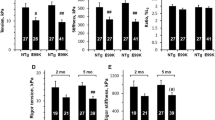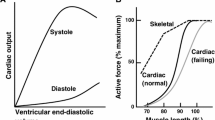Abstract
We have tested the hypothesis that alterations in length dependent activation (LDA) of cardiac myofilaments represent an important regulatory mechanism affecting the Frank–Starling mechanism as determined by the slope (Ees) of the relation between left ventricular (LV) volume and end-systolic pressure. We employed a transgenic (TG) mouse model in which the cardiac isoform of TnI (cTnI) has been completely replaced with slow skeletal TnI (ssTnI), the embryonic/neonatal isoform in the heart. Compared to non-transgenic (NTG) controls, myofilaments from TG–ssTnI hearts demonstrate an increase in Ca2+ sensitivity and a substantially blunted LDA that is unaffected by PKA-dependent phosphorylation. We measured in situ LV pressure and volume relations during basal conditions and isoproterenol (ISO) stimulation. In the basal state in TG–ssTnI hearts there was significant increase in end-systolic pressure and slight decrease in heart rate. ISO stimulation resulted in a significant increase in heart rate, ejection fraction, maximum dP/dt, preload-recruitable stroke work, maximum dP/dt versus end diastolic volume and cardiac output in both groups. During basal conditions there was no difference in the Ees relation between NTG and TG–ssTnI groups. However, during ISO stimulation the Ees relation was significantly different between NTG and TG–ssTnI groups. Our study provides the first direct evidence that enhancement in differences in LDA between cardiac myofilaments from NTG and TG–ssTnI hearts induced by post-translational modifications of sarcomeric proteins are reflected in the in situ beating heart by a different change in Ees. Thus, changes in LDA should be considered in interpreting results from in situ experiments on inotropic effects associated with physiological and patho-physiological states of the heart.



Similar content being viewed by others
References
Arteaga GM, Palmiter KA, Leiden JM, Solaro RJ (2000) Attenuation of length dependence of calcium activation in myofilaments of transgenic mouse hearts expressing slow skeletal troponin I. J Physiol 526:541–549
Cazorla O, Wu Y, Irving TC, Granzier H (2001) Titin-based modulation of calcium sensitivity of active tension in mouse skinned cardiac myocytes. Circ Res 88:1028–1035
Evans CC, Pena JR, Phillips RM, Muthuchamy M, Wieczorek DF, Solaro RJ, Wolska BM (2000) Altered hemodynamics in transgenic mice harboring mutant tropomyosin linked to hypertrophic cardiomyopathy. Am J Physiol 279:H2414–H2423
Feldman MD, Erikson JM, Mao Y, Korcarz CE, Lang RM, Freeman GL (2000) Validation of a mouse conductance system to determine LV volume: comparison to echocardiography and crystals. Am J Physiol Heart Circ Physiol 279:H1698–H1707
Fentzke RC, Buck SH, Patel JR, Lin H, Wolska BM, Stojanovic MO, Martin AF, Solaro RJ, Moss RL, Leiden JM (1999) Impaired cardiomyocyte relaxation and diastolic function in transgenic mice expressing slow skeletal troponin I in the heart. J Physiol 517:143–157
Fukuda N, Sasaki D, Ishiwata S, Kurihara S (2001) Length dependence of tension generation in rat skinned cardiac muscle: role of titin in the Frank–Starling mechanism of the heart. Circulation 104:1639–1645
Goldspink PH, Montgomery DE, Walker LA, Urboniene D, McKinney RD, Geenen DL, Solaro RJ, Buttrick PM (2004) Protein kinase Cε overexpression alters myofilament properties and composition during the progression of heart failure. Circ Res 95:424–432
Hoit BD (2002) Echocardiographic assessment of the mouse heart and aorta. In Hoit BD, Walsh RA (eds) Cardiovascular physiology in the genetically engineered mouse. Kluwer Academic Publishers, Boston/Dordrecht/London, pp 177–190
Irving TC, Konhilas J, Perry D, Fischetti R, de Tombe PP (2000) Myofilament lattice spacing as a function of sarcomere length in isolated rat myocardium. Am J Physiol Heart Circ Physiol 279:H2568–H2573
Kajiwara H, Morimoto S, Fukuda N, Ohtsuki I, Kurihara S (2000) Effect of troponin I phosphorylation by protein kinase A on length-dependence of tension activation in skinned cardiac muscle fibers. Biochem Biophys Res Commun 272:104–110
Komukai K, Kurihara S (1997) Length dependence of Ca(2+)-tension relationship in aequorin-injected ferret papillary muscles. Am J Physiol 273:H1068–H1074
Konhilas JP, Irving TC, de Tombe PP (2002) Length-dependent activation in three striated muscle types of the rat. J Physiol 544:225–236
Konhilas JP, Irving TC, Wolska BM, Jweied EE, Martin AF, Solaro RJ, Tombe PP (2003) Troponin I in the murine myocardium: influence on length-dependent activation and interfilament spacing. J Physiol 547:951–961
Layland J, Grieve DJ, Cave AC, Sparks E, Solaro RJ, Shah AM (2004) Essential role of troponin I in the positive inotropic response to isoprenaline in mouse hearts contracting auxotonically. J Physiol 556:835–847
Lorenz JN, Kranias EG (1997) Regulatory effects of phospholamban on cardiac function in intact mice. Am J Physiol 273:H2826–H2831
Pena JR, Wolska BM (2004) Troponin I phosphorylation plays an important role in the relaxant effect of β-adrenergic stimulation in mouse hearts. Cardiovasc Res 61:756–763
Pyle WG, Solaro RJ (2004) At the crossroads of myocardial signaling: the role of Z-discs in intracellular signaling and cardiac function. Circ Res 94:296–305
Solaro RJ (1999) Integration of myofilament response to Ca2+ with cardiac pump regulation and pump dynamics. Am J Physiol 277:S155–S163
Urboniene D, Dias FA, Pena JR, Walker LA, Solaro RJ, Wolska BM (2005) Expression of slow skeletal troponin I in adult mouse heart helps to maintain the left ventricular systolic function during respiratory hypercapnia. Circ Res 97:70–77
Van der Velden J, de Jong VJW, Owen VJ, Burton PB, Stienen GJ (2000) Effect of protein kinase A on calcium sensitivity of force and its sarcomere length dependence in human cardiomyocytes. Cardiovasc Res 46:487–495
Wolska BM, Arteaga GM, Pena JR, Nowak G, Phillips RM, Sahai S, de Tombe PP, Martin AF, Kranias EG, Solaro RJ (2002) Expression of slow skeletal troponin I in hearts of phospholamban knockout mice alters the relaxant effect of β-adrenergic stimulation. Circ Res 90:882–888
Acknowledgments
This research was supported by NIH research grants RO1 HL-64209 (B.M.W.), RO1 HL-79032 (B.M.W.), R37 HL-22231 (R.J.S.) and PO1 HL-62426 (R.J.S.).
Author information
Authors and Affiliations
Corresponding author
Rights and permissions
About this article
Cite this article
Nowak, G., Peña, J.R., Urboniene, D. et al. Correlations between alterations in length-dependent Ca2+ activation of cardiac myofilaments and the end-systolic pressure–volume relation. J Muscle Res Cell Motil 28, 415–419 (2007). https://doi.org/10.1007/s10974-008-9136-y
Received:
Accepted:
Published:
Issue Date:
DOI: https://doi.org/10.1007/s10974-008-9136-y




